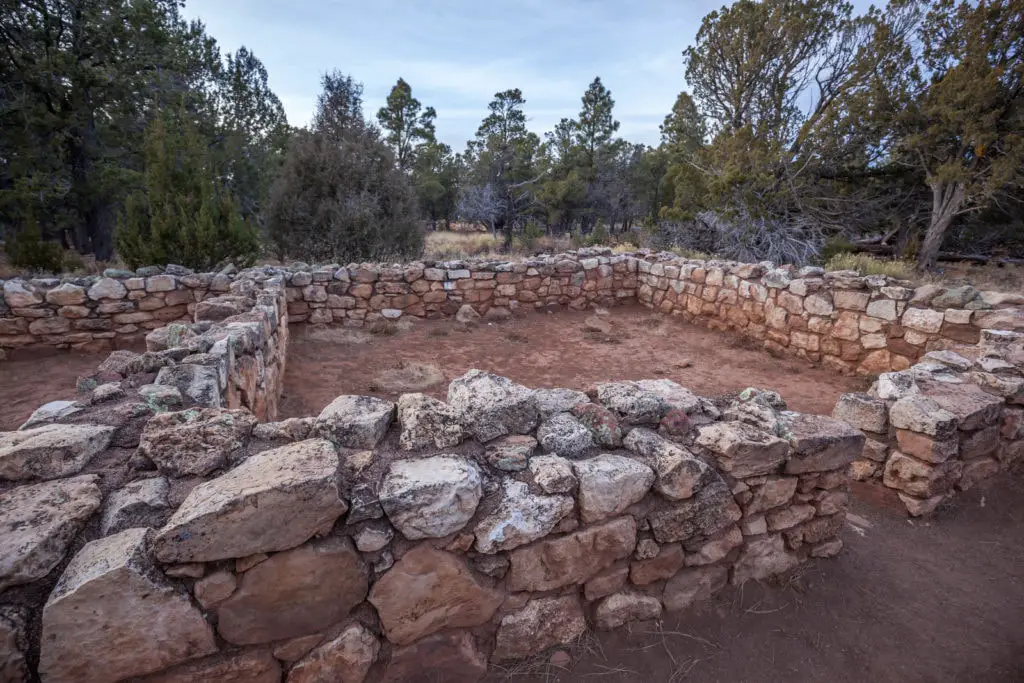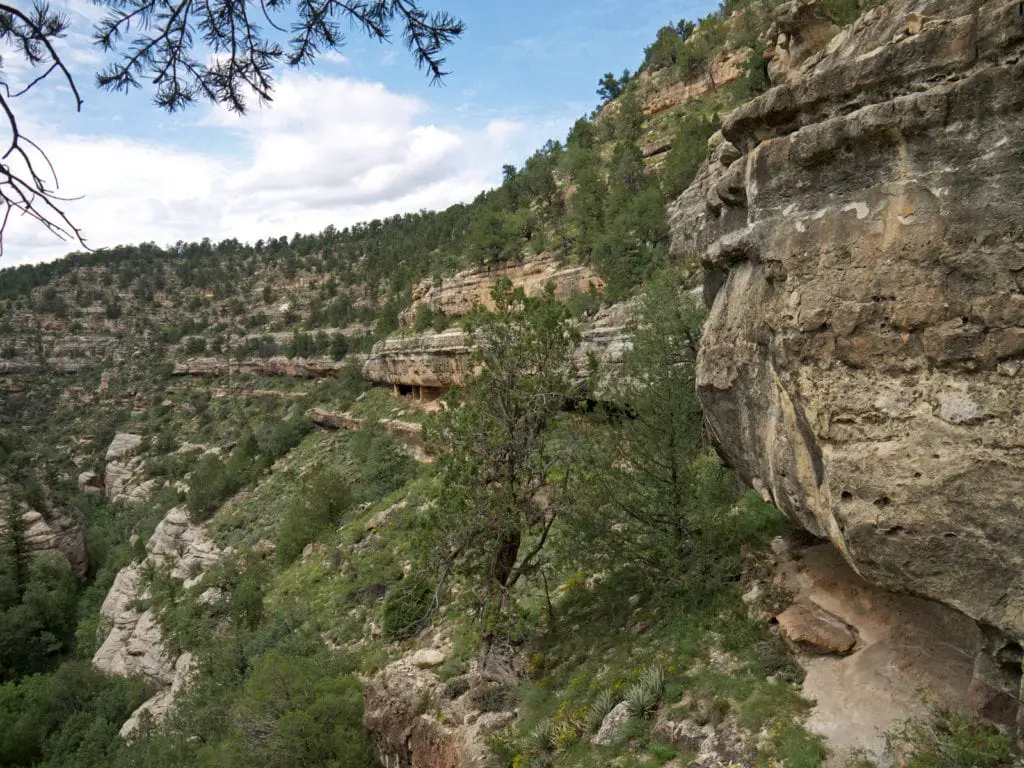Arizona, a state brimming with natural phenomena, is home to numerous tourist hotspots. Often lost in the mix of things this state has to offer, is a canyon that was once home to a pre-Columbian community that you may have heard about. Conveniently located just off the freeway, and only ten miles southeast of Flagstaff, Walnut Canyon National Monument is a rocky terrain you won’t want to miss.
Walnut Canyon National Monument, once home to hundreds of Sinagua people, is now a nationally preserved landmark in Arizona. Although the Sinagua only occupied this land for roughly 150 years (1100-1250 CE), they left a plethora a history and information, giving researchers around the nation a better understanding of the lifestyle of this pre-Columbian culture.
The word “Sinagua” simply translates to “without water.” The people of this region are referred to as “Sinagua” because of their incredible ability to live in such dry and arid conditions. The Sinagua were experts at conserving their water, but make sure you bring enough on your trip to the park. The day is long and filled with activities to do—you don’t want to miss a thing! To make sure you optimize your time here, we’ve put together a list of things you should know before you pack your bags:
- What is Walnut Canyon National Monument known for?
- What are the top spots to see at Walnut Canyon National Monument?
- Hiking/Trails Information
- Camping Information
- Where to Stay
Keep reading and before you know it, you’ll find yourself booking a ticket to Walnut Canyon National Monument.

1. What is Walnut Canyon National Monument known for?
Walnut Canyon itself is estimated to have formed around 60 million years ago, due to large amounts of erosion caused by wind and flowing water—it’s old! Yet, for much of history, the area was only home to diverse plants, and many animals.
The Sinagua were a tight knit community that settled throughout various parts of Arizona between 500CE and 1425 CE. The Sinagua people stumbled across this canyon in 1100CE. After settlement, this community only spent 115 years in the Walnut Canyon area. Even though their stay was short, the history they left behind is rich, and still studied today.
During their stay, the Sinagua developed unique cave-like homes within the alcoves of the canyon. Most of the dwellings are carved into the southern and eastern portions of the canyon, to maximize the amount of sunlight shed on their homes.
During their stay, this community was based mostly on agriculture. Due to the substantial heat and dryness of the area, they partook in a unique style of farming known as “dry-farming,” allowing them to harvest beans, corn, and various other necessary foods.
The Sinagua people were also known to be highly skilled traders. It is thought that their trading routes often extended as far as the Gulf of Mexico!
At around 1250 CE, the Sinagua people mysteriously packed their bags, and left this area. Some say it was due to the rising tensions between neighboring tribes. Others say they left in search of more fertile lands. One theory is simply that the Sinagua never saw this as a permanent residence. As quickly as they came, when they felt the time was right, they left. Regardless of their intentions, the Sinagua people left behind some beautiful infrastructure and a deep history, leaving much to learn for both archaeologists and tourists like you.
Still need more proof that this spot is worth checking out?
Hundreds of years later (1915), in an attempt to keep the area and the history preserved, Walnut Canyon was proclaimed a national monument by former president Woodrow Wilson. In 1966, the national monument was recognized on the National Register of Historic Places—a list of places and objects deemed worthy of cultural preservation due to their significance to American history.
The abandonment of this area has made this corner of Arizona a beautiful spot for tourists. Lucky for us, a lot of the Sinagua homes and way of life have been carefully preserved for the world to see.

2. What are the top spots to see at Walnut Canyon National Monument?
The canyon is what this whole attraction is based around. With a rim elevation at roughly 6690 feet, and a floor 350 feet below, this canyon is where the Sinagua people settled for over 100 years. While you’re walking through parts of the canyon, make sure you keep an eye out for a few things:
Sinagua Dwellings
The upper layer of this canyon is made from Kaibab limestone and was used by the Sinagua people to build their homes. Within the within this layer are the famous homes that people from all around the nation come to see. Each room carved into the rocky terrain was home to a single family. Here they would sleep, cook, and spend their free time.
The ingenuity of the Sinagua people is evident in these dwellings. By building their homes into the canyon, much of the walls and ceilings were already made for them. All they had to do was build some partitions as they saw fit. The Sinagua’s careful planning was key to their success and led to a prosperous time in this area.
To get the best view of these dwellings, you will definitely want to hike through the trails that this area has to offer.

Plant Life
Furthermore, Walnut Canyon National Monument is known for its plethora of plant life throughout the area—over 300 unique plants can be found growing in and around the canyon. Walnut Canyon is a spot where various communities of plant life overlap—species that are usually separated, find homes and harmony here. If you are a first-time visitor, you may have a hard time identifying much of the vegetation you see growing. From saguaro cactus to walnut trees, this area may be home to many plants you have never seen before. You may be tempted to keep your eyes high and focused on the rocky terrain, but don’t forget there is much to adore growing just near your feet too!
Need more information about the dwellings of the plants you see during your walks? The tour guides are well prepared to answer any questions you may have. If you wish to take on Walnut Canyon National Monument on your own, stop by the visitor center and pick up a few pamphlets to aid you throughout the day.
3. Hiking/Trails Information
There are two main hiking trails that this national monument has to offer. If you have the time, we highly recommend strolling through both. One is a cake walk, the other may be tough. Remember to bring a good pair of boots.
Walnut Canyon Rim Trail
Need a relaxed trail after your long day? This partially paved trail is a stop worth making. With two overlook spots, you can get a clear view of the entire canyon, and the cliff dwellings down below. On this trail, you’ll have a good view of the scattered ruins in the area as well.
If your trip is planned for the summer, make sure to stop by the demonstration garden where you can see some of the traditional crops grown by the Sinagua. At less than a mile and with a smooth path, this trail is simple and shouldn’t be missed.
This is the easier of the two trails, so definitely swing by and take a stroll down Walnut Canyon Rim Trail!
(Trail Level: Easy)
The Island Trail
Looking for a workout? This one-mile round trip will give you just the exercise you need. This stunning trail gives tourists a first-hand view of how many of the Sinagua people lived. You can look into dozens of cliff dwelling rooms scattered across the path and walk through 800-year-old structures. The stunning views coupled with the rich history of this area make every ounce of sweat worth it.
At nearly 7000 feet, this trail may be difficult for some tourists. The ups and downs can be hard for those not acclimated to high elevations. But don’t worry—there are many benches and natural stopping points throughout the trail. If you are nervous, feel free to skip this one. There is plenty more to do!
In the winter (remember, it snows in Arizona too!), this trail may close on certain days due to icy conditions, and the unsafety that it brings. To get the most out of this trail, spring, summer, and fall is your best bet. Although the natural beauty that comes with winter is worth seeing, the chance this path is closed may be high. To check the current status of this trail, click here.
It is worth further noting that although the trail is paved, it is not wheelchair accessible. This is simply due to the steepness of some portions, and the stairs that need to be climbed at certain parts of the trail.
Although you may see many ruins on your walks through the rocky canyon, it is important to keep in mind that a few ruins in the park area are not open to the public. For both preservation and safety reasons, tourists are asked to be weary of this, and listen keenly to make sure you are doing your best to stay safe and keep the park protected.
(Trail Level: Moderate)
4. Camping Information
Unfortunately, there are no campgrounds at Walnut Canyon National Monument. The area is heavily protected, and so you won’t be able to stake your tent inside the park. That being said, if spending a night under the stars is on your mind, we highly recommend Bonito Campground, just across from the visitor center. Open from late May through mid-October, this camping spot will take care of all your camping needs. With plenty of space to get comfortable, this campground is a hot spot for tourists in the summer.
If you are okay looking a little further out from the Flagstaff area, Arizona is filled with camping spots that are open most of the year. Our personal favorites are:
- Flagstaff KOA (5.5 miles to downtown Flagstaff, reservations taken)
- White Horse Lake Campground (36.4 miles, reservations taken)
- Lockett Meadow Campground (22.2 miles, no reservations—first-come, first-served)
- Freidlein Prairie Dispersed Camping (10 miles, no reservations—first-come, first-served)
Remember, it is important that you review the specific guidelines for each of these campgrounds. Depending on the site, the rules and regulation may slightly differ, and it is in your best interest to know the dos and don’ts of the spot before you spend the night!
5. Where to Stay
If camping isn’t your style, have no fear. Due to the growing popularity of Walnut Canyon National Monument, there are plenty of options for indoor housing during your time here.
With Flagstaff just miles away, finding a hotel or Airbnb is a nonissue. Depending on the time of year, however, prices and availability may drastically vary, so make sure you book in advance if you see something you like! Like most spots in Arizona, the area can get crowded in the summer, so plan accordingly.
If you do end up here during the summer, our strong recommendation would be to spend a night on the nearby camping grounds. There is nothing quite like spending your day indulging in the lifestyle of the Sinagua people and spending your night out in the woods. If you wish to come in the wintertime, however, your best bet will be a hotel in Flagstaff. The town is filled with restaurants and is a great way to round out your trip to Arizona. If you wish to see how people live in the once Sinagua-occupied area, Flagstaff would be a great spot for you.
Here are a few of our favorite hotels in the area:
Finding an Airbnb is becoming more and more common in this tourist hot spot as well. If you are more comfortable doing this, you will be able to find ample housing. Still, our recommendation would be to book ahead of time.
Ready to book your flight? There are a few things we want to reiterate:
Don’t let the infamous Arizona heat fool you. From December to March, it is not uncommon to see snow fall in Walnut Canyon. At roughly 6690 feet above sea level, winters can get relatively cold—plan accordingly!
But, if you want to see the canyon during the beautiful winter months, you’re in luck, as this park is open every day of the year, other than Christmas. The park is accessible from 8AM-5PM MST from the month of May to October and is open from 9AM-5PM MST the rest of the year.
Lastly, pets are not allowed anywhere in the park. In order to keep the area clean, pets must be left at home. On the same note, any animals you see at the park, should be left alone—steer clear of feeding them.
Tucked away in the beautiful Arizona landscape, the Walnut Canyon National monument is a stop you will regret missing. Bring a friend, grab a pair of binoculars and head on over. Take a hike, listen to the rich historical stories, and let your imagination take you to a time hundreds of years ago!

